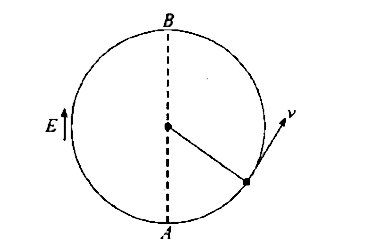In the previous problem, if time period, T=2(π)mBQ where Q is the charge of the particle and m is its mass, the ratio of time spent by the particle in field when (θ) is positive to when (θ) is negative is given by
(π/2+θπ/2−θ)
(π+θπ−θ)
(π−θπ+θ)
(π/2−θπ/2+θ)
The correct Answer is:A
To solve the problem, we need to find the ratio of the time spent by a charged particle in a magnetic field when the angle θ is positive to when θ is negative. The time period T is given by the formula:
T=2πmqB
where q is the charge of the particle, m is its mass, and B is the magnetic field strength.
1. Understand the Geometry of Motion:
- When the angle θ is positive, the particle traces a certain path in the magnetic field. The angle subtended by the path in the magnetic field can be denoted as α1.
- When the angle θ is negative, the particle traces a different path, and the angle subtended in this case can be denoted as α2.
2. Determine the Angles:
- For the case where θ is positive, the total angle traced in the magnetic field can be calculated as:
α1=2π−(90∘+90∘)+2θ=π+2θ
- For the case where θ is negative, the angle traced can be calculated as:
α2=(90∘−θ)+(90∘−θ)=180∘−2θ=π−2θ
3. Calculate the Time Periods:
- The time spent in the magnetic field when θ is positive is proportional to α1:
T1∝α1=π+2θ
- The time spent in the magnetic field when θ is negative is proportional to α2:
T2∝α2=π−2θ
4. Form the Ratio:
- The ratio of the time periods T1 and T2 can be expressed as:
T1T2=π+2θπ−2θ
5. Simplify the Ratio:
- To express the ratio in a simpler form, we can divide both the numerator and denominator by 2:
T1T2=π2+θπ2−θ
Final Answer:
The ratio of the time spent by the particle in the field when θ is positive to when θ is negative is:
T1T2=π2+θπ2−θ
- When the angle θ is positive, the particle traces a certain path in the magnetic field. The angle subtended by the path in the magnetic field can be denoted as α1.
- When the angle θ is negative, the particle traces a different path, and the angle subtended in this case can be denoted as α2.
- For the case where θ is positive, the total angle traced in the magnetic field can be calculated as:
α1=2π−(90∘+90∘)+2θ=π+2θ
- For the case where θ is negative, the angle traced can be calculated as:
α2=(90∘−θ)+(90∘−θ)=180∘−2θ=π−2θ
- The time spent in the magnetic field when θ is positive is proportional to α1:
T1∝α1=π+2θ
- The time spent in the magnetic field when θ is negative is proportional to α2:
T2∝α2=π−2θ
- The ratio of the time periods T1 and T2 can be expressed as:
T1T2=π+2θπ−2θ
- To express the ratio in a simpler form, we can divide both the numerator and denominator by 2:
T1T2=π2+θπ2−θ
The ratio of the time spent by the particle in the field when θ is positive to when θ is negative is:
Topper's Solved these Questions
- MISCELLANEOUS VOLUME 5Book:CENGAGE PHYSICS ENGLISHChapter:MISCELLANEOUS VOLUME 5Exercise:Multiple Correct
Explore 34 Videos
- MISCELLANEOUS VOLUME 5Book:CENGAGE PHYSICS ENGLISHChapter:MISCELLANEOUS VOLUME 5Exercise:Linked Comprehension
Explore 84 Videos
- MISCELLANEOUS VOLUME 3Book:CENGAGE PHYSICS ENGLISHChapter:MISCELLANEOUS VOLUME 3Exercise:True and False
Explore 3 Videos
- NUCLEAR PHYSICSBook:CENGAGE PHYSICS ENGLISHChapter:NUCLEAR PHYSICSExercise:ddp.5.5
Explore 14 Videos
Similar Questions
In the previous problem, the maximum range of movement of the centre of the part of the circle from line AD in which charged particle of charge Q moves with a velocity v when (θ) is positive to when (θ) is negative is given by
View SolutionIn the previous question,if the particle has−Q charge the time spend by the particle in the field will be .
View SolutionIf the ratio of time periods of circular motion of two charged particles in magnetic field in 1/2, then the ratio of their kinetic energies must be :
View SolutionIf the speed v of a particle of mass m as function of time t is given by v=ωAsin[(√km)t], where A has dimension of length.
View SolutionIf a charged particle is a plane perpendicular to a uniform magnetic field with a time period T Then
View SolutionIf a charged particle of charge to mass ratio (qm)=α centers in a magnetic field of strength B at a speed v=(2αd)(B), then

View SolutionA particle executes a simple harmonic motion of time period T. Find the time taken by the particle to go directly from its mean position to half the amplitude.
View SolutionThe velocity of the particle of mass m as a function of time t is given by v=Aω.cos[√Kmt] , where A is amplitude of oscillation. The dimension of AK is
View SolutionThe velocity time relation of a particle is given by v =(3t2−2t−1)m/s Calculate the position and acceleration of the particle when velocity of the particle is zero . Given the initial position of the particle is 5m .
View SolutionA particle of mass m and charge Q is attached to a string of length l. It is whirled in a vertical circle in the region of an electric field E as shown in the figure-5.105.What is the speed given to the particle at the point B,so that tension in the string when the particle is at A is ten times the weight of the particle?

View Solution